LIM zinc finger domain containing 2 is a protein that in humans is encoded by the LIMS2 gene. [5]
LIM zinc finger domain containing 2 is a protein that in humans is encoded by the LIMS2 gene. [5]
This gene encodes a member of a small family of focal adhesion proteins which interacts with ILK (integrin-linked kinase), a protein which effects protein-protein interactions with the extraceullar matrix. The encoded protein has five LIM domains, each domain forming two zinc fingers, which permit interactions which regulate cell shape and migration. A pseudogene of this gene is located on chromosome 4. Multiple transcript variants encoding different isoforms have been found for this gene. [provided by RefSeq, Nov 2011].
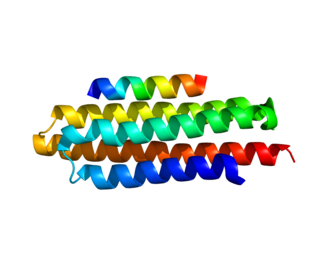
Paxillin is a protein that in humans is encoded by the PXN gene. Paxillin is expressed at focal adhesions of non-striated cells and at costameres of striated muscle cells, and it functions to adhere cells to the extracellular matrix. Mutations in PXN as well as abnormal expression of paxillin protein has been implicated in the progression of various cancers.

Testin also known as TESS is a protein that in humans is encoded by the TES gene located on chromosome 7. TES is a 47 kDa protein composed of 421 amino acids found at focal adhesions and is thought to have a role in regulation of cell motility. In addition to this, TES functions as a tumour suppressor. The TES gene is located within a fragile region of chromosome 7, and the promoter elements of the TES gene have been shown to be susceptible to methylation – this prevents the expression of the TES protein. TES came to greater prominence towards the end of 2007 as a potential mechanism for its tumour suppressor function was published.
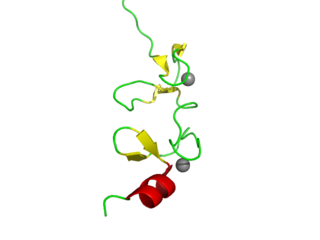
LIM domains are protein structural domains, composed of two contiguous zinc fingers, separated by a two-amino acid residue hydrophobic linker. The domain name is an acronym of the three genes in which it was first identified. LIM is a protein interaction domain that is involved in binding to many structurally and functionally diverse partners. The LIM domain appeared in eukaryotes sometime prior to the most recent common ancestor of plants, fungi, amoeba and animals. In animal cells, LIM domain-containing proteins often shuttle between the cell nucleus where they can regulate gene expression, and the cytoplasm where they are usually associated with actin cytoskeletal structures involved in connecting cells together and to the surrounding matrix, such as stress fibers, focal adhesions and adherens junctions.

Integrin-linked kinase is an enzyme that in humans is encoded by the ILK gene involved with integrin-mediated signal transduction. Mutations in ILK are associated with cardiomyopathies. It is a 59kDa protein originally identified in a yeast-two hybrid screen with integrin β1 as the bait protein. Since its discovery, ILK has been associated with multiple cellular functions including cell migration, proliferation, and adhesion.

PTK2 protein tyrosine kinase 2 (PTK2), also known as focal adhesion kinase (FAK), is a protein that, in humans, is encoded by the PTK2 gene. PTK2 is a focal adhesion-associated protein kinase involved in cellular adhesion and spreading processes. It has been shown that when FAK was blocked, breast cancer cells became less metastatic due to decreased mobility.

Transforming growth factor beta-1-induced transcript 1 protein is a protein that in humans is encoded by the TGFB1I1 gene. Often put together with and studied alongside TGFB1I1 is the mouse homologue HIC-5. As the name suggests, TGFB1I1 is an induced form of the larger family of TGBF1. Studies suggest TGBF1I1 plays a role in processes of cell growth, proliferation, migration, differentiation and senescence. TGBF1I1 is most localized at focal adhesion complexes of cells, although it may be found active in the cytosol, nucleus and cell membrane as well.
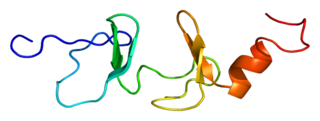
Four and a half LIM domains protein 2 also known as FHL-2 is a protein that in humans is encoded by the FHL2 gene. LIM proteins contain a highly conserved double zinc finger motif called the LIM domain.

Alpha-actinin-4 is a protein that in humans is encoded by the ACTN4 gene.

Zyxin is a protein that in humans is encoded by the ZYX gene.

Cytoplasmic protein NCK2 is a protein that in humans is encoded by the NCK2 gene.
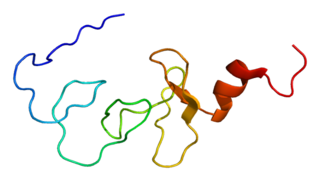
LIM domain kinase 2 is an enzyme that in humans is encoded by the LIMK2 gene.

Thyroid receptor-interacting protein 6 is a protein that in humans is encoded by the TRIP6 gene.

LIM and senescent cell antigen-like-containing domain protein 1 is a protein that in humans is encoded by the LIMS1 gene.

Alpha-parvin is a protein that in humans is encoded by the PARVA gene.

Glucocorticoid receptor DNA-binding factor 1 is a protein that in humans is encoded by the GRLF1 gene.
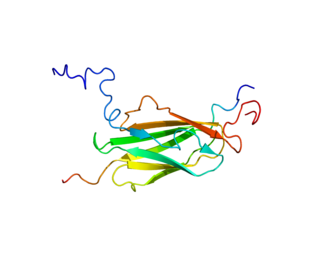
Filamin-binding LIM protein 1 is a protein that in humans is encoded by the FBLIM1 gene.

Zinc finger protein 43 is a protein that in humans is encoded by the ZNF43 gene.

Zinc finger protein 202 is a transcription factor first associated with breast cancer. It is a protein that, in humans, is encoded by the ZNF202 gene.

Zinc finger and BTB domain-containing protein 32 is a protein that in humans is encoded by the 1960 bp ZBTB32 gene. The 52 kDa protein is a transcriptional repressor and the gene is expressed in T and B cells upon activation, but also significantly in testis cells. It is a member of the Poxviruses and Zinc-finger (POZ) and Krüppel (POK) family of proteins, and was identified in multiple screens involving either immune cell tumorigenesis or immune cell development.

Transcription factor HIVEP3 is a protein that in humans is encoded by the HIVEP3 gene.
This article incorporates text from the United States National Library of Medicine, which is in the public domain.